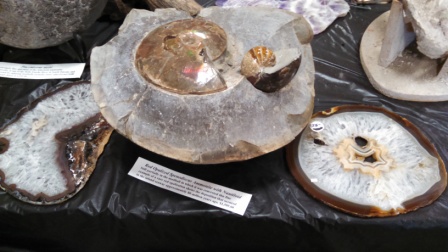|
1/5/2016 0 Comments Ammonite versus Ammolite At center: Red Opalized Spenodiscus Ammonite with Nautiloid At center: Red Opalized Spenodiscus Ammonite with Nautiloid One letter makes a world of difference. In book two of my Rock Shop Mystery series, Stone Cold Case, the discovery of a rare gemstone stirs up a dangerous treasure hunt in the Colorado Rockies. Ammonite and ammolite are both the result of the fossilization of now extinct cephalopods. The nautilus is its closest living relative. You may purchase a polished ammonite, perhaps as a pendant or earrings, for the price of costume jewelry. A shame, since it took nature a long time to fossilize the cephalopod. Of greater value is ammolite, formed of the same extinct animal but fossilized with different minerals. According to Virtual Fossil Museum, "During fossilization, the nacreous layer of some ammonites was chemically transformed into an iridescent material called ammolite, which is aragonite with varying mineral impurities that is considered to be an opal-like gemstone." Ammonite is found all over planet earth. Look for it at your local rock shop. Ammolite is a rare form of ammonite. One of the main locations of ammolite is a mine in Southern Alberta, Canada. Due to its rarity, ammolite commands a far higher price than ammonite. In Stone Cold Case, I faced the problem of making sure the reader knew which version of the mineral I was referencing. When reading, your brain tends to fill in information automatically. Here's how I explained the difference between ammonite and ammolite in the first scene mentioning the fossils: Morgan held one of her larger pieces next to the photos. “That’s it.” “Ammolite is an organic gem.” “I thought all rocks were organic.” “People call everything organic nowadays,” Del said. “They throw the word around to make things sound healthy. I mean organic in the sense that it was alive once. Rocks are minerals, but ammonites are fossils. Shells, specifically. And when just the right minerals happen along during the fossilization process, it turns into this.” He picked up a dazzling blue, green, and gold gem. “Ammolite.” Morgan skimmed the paragraph in the book on how ammolite forms. “So there are only three gemstones produced by living organisms. This stuff, pearls, and amber. Wow.” “If there’s ammolite in the hills around here, all heck will break loose.” “So ammolite is valuable?” “Very rare.” Del picked up a chip and studied it. “If you had ammolite on your property, you’d have no money problems.” For more photos and information on ammonite and ammolite, check the links below: http://www.fossilmuseum.net/Fossil_Galleries/Ammonites.htm http://geology.com/stories/13/ammolite/ https://www.gemsociety.org/article/ammolites-jewelry-and-gemstone-information/ http://animals.nationalgeographic.com/animals/prehistoric/ammonites/
0 Comments
Your comment will be posted after it is approved.
Leave a Reply. |
Subscribe to this blog: |
Proudly powered by Weebly
 RSS Feed
RSS Feed